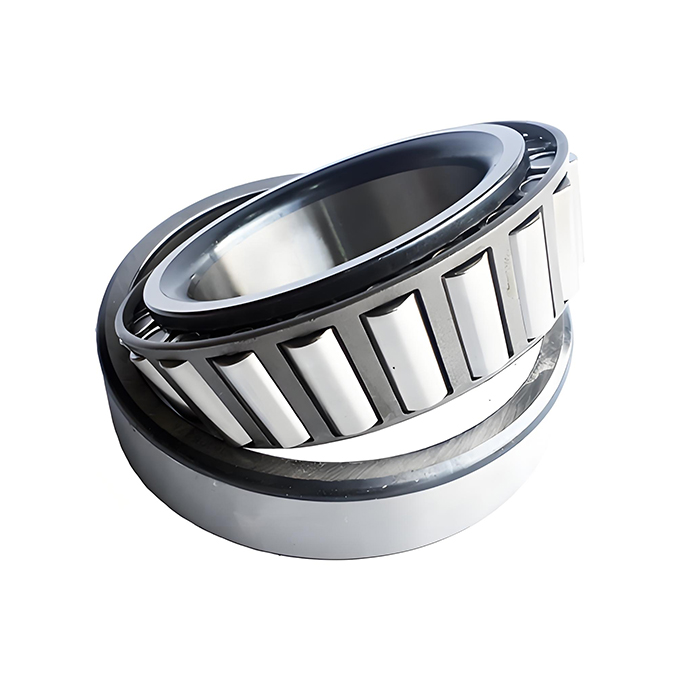Classification of anti-friction bearings, Most bantalan bergulirs consist of bearing rings (an inner ring and an outer ring), rolling elements and a rolling element retainer (cage). The retainer separates the rolling elements at regular intervals, holds them in place within the inner and outer raceways, and allows them to rotate freely.

Rolling bearings fall into two main classifications: bantalan bolas and roller bearings. Balls geometrically contact the raceway surfaces of the inner and outer rings at “points,” while the contact surface of rollers is a “line” contact. Rollers come in four basic geometric styles: cylindrical, needle, tapered and spherical. Rolling bearings can further be classified according to the direction in which the load is applied: radial, thrust, or a combination
of both.

While the rolling elements and the bearing rings take any load applied to the bearings (at the contact point between the rolling elements and raceway surfaces), the retainer takes no direct load. It only serves to hold the rolling elements at equal distances from each other, forcing the rolling elements to enter the load zones and prevent them from falling out.
Design and Characteristics of Ball and Bantalan Rol Chart
Isi
SINGLE ROW RADIAL BALL BEARINGS are the most widely used bearings and utilize an uninterrupted raceway, which makes these bearings suitable for radial loads, or a combination of thrust and radial loads. This design permits precision tolerances even at high speed operation. The cage in this bearing is pressed steel. For high speed bearings, machined brass cages are available. Bearings with locating snap rings are also available.
PRELUBRICATED BEARINGS have integral seals, or shields, which are packed with long-life grease. In many applications, these bearings may be used without supplementary seals, closures, or protective devices. This design offers the lowest possible manufacturing cost to the consumer. The boundary dimension of this type is the same as the corresponding bearings without the seals or shields.
SHIELDED BALL BEARINGS are protected on one, or both sides (suffixes Z and ZZ, respectively) by metal shields fastened to the outer ring. This close clearance labyrinth seal retains the lubricant and prevents the entrance of foreign matter.
SEALED BALL BEARINGS incorporate steel reinforced rubber seals securely fastened to a groove on the outer ring. Contact with the inner ring is by sealing lip (Contact Suffix 2RS is standard, LLU is used by NTN Bearings). Or, non-contact with the inner ring is by labyrinth seal (Non-contact Suffix LLB is used by NTN Bearings) to provide positive sealing at all times.
SINGLE ROW ANGULAR CONTACT BALL BEARINGS feature raceways with high and low shoulders. These opposing raceways are designed to carry thrust load in
one direction. These bantalan may be preloaded at the factory so that the correct preload will develop within the bearing. The bearings in this series are assembled with a specific internal clearance so that they will have a specified contact angle under load.
DOUBLE ROW ANGULAR CONTACT BALL BEARINGS have an inner and outer ring with a double raceway. The two rows are so related that the contact angle is similar to a pair of back-to-back single row bearings. Some series offer continuous races and can carry thrust loads in either direction. Other series have filling slots, it is necessary to mount them with the thrust load acting against the unnotched face of the rings.
DOUBLE ROW SELF-ALIGNING BEARINGS utilize an inner ring with two rows of balls in two deep raceways, and an outer ring with a single spherical raceway. In this
way, the inner and outer rings can be misaligned relative to each other. The resulting effect is a comparatively large angle imposing moment loads upon the balls.
CYLINDRICAL ROLLER BEARINGS have rollers which are essentially cylindrical in shape. This provides a modified line contact with the cylindrical inner and outer ring
raceways, while the rollers are guided by ground ribs on either the inner or outer ring.
TAPERED ROLLER BEARINGS utilize conical rollers and raceways arranged so that the rollers and raceways meet at a common apex. The rollers are guided by contact between the large end of the roller and a rib on the inner ring. This provides high capacity for radial and single thrust loads.
SPHERICAL ROLLER BEARINGS have two rows of rollers in separate raceways which allows the bearing to compensate for angular thrust errors. They have large radial and thrust load capacity for heavy shock and impact loads, making them suitable for heavy industrial equipment.
DUPLEX BEARINGS use a set of two on a common shaft with the inner and outer rings clamped solidly together. They are used to gain axial shaft control, rigidity and extra capacity.There are three fundamental combinations in duplex bearings: face-to-face (DF), back-to-back (DB), and tandem (DT).
SINGLE DIRECTION THRUST BEARINGS
SINGLE DIRECTION THRUST BEARINGS consist of two washers having ball grooves ground into their adjacent faces with balls and cages mounted between these
grooves. They are normally equipped with either pressed or machined cages and are suitable for carrying thrust loads at moderate speeds.
DOUBLE DIRECTION ANGULAR CONTACT THRUST BALL BEARINGS are back-to-back duplex bearings with a larger contact angle than that of normal angular contact ball bearings. These bearings are primarily designed as thrust bearings for machine tools. They utilize machined brass cages.
SPHERICAL ROLLER THRUST BEARINGS are similar to double row spherical roller bearings, but have a greater contact angle. They are guided by ground flanges on the inner ring and operate against the spherical raceway in the outer ring. The contact angle is approximately 45°. Machined cages are normally used, and oil lubrication is recommended.
BEARING UNITS consist of a ball or roller bearing installed within a housing. The housings are most commonly made of cast iron but may also be made of other metals or nonmetallic materials. The housing provides rigidity and secure positioning for the bearing within the application. It also simplifies the task of replacing the bearing as the housing and bearing can be replaced as a complete unit.